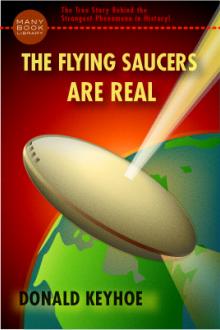The Flying Saucers are Real by Donald Keyhoe (best classic novels .TXT) 📕

- Author: Donald Keyhoe
- Performer: -
Book online «The Flying Saucers are Real by Donald Keyhoe (best classic novels .TXT) 📕». Author Donald Keyhoe
Even the disbelievers asked for more information. The intelligence level of the average letter was gratifyingly high. Comments came from scientists, engineers, airline and private pilots, college professors, officers of the armed
{p. 144}
services, and a wide variety of others—including far more women than True’s readership usually includes.
Several confidential tips had come in when I arrived. Most of them were from usually reputable sources. We were given evidence that Project “Saucer” was still in operation; since its true code name was not “Saucer,” it could be continued without violating the Air Force press release. This same information was received from a dozen sources within the next two weeks. We were also told that there had been 722 cases, instead of 375.
Meantime, a number of astronomers had come out with statements, pro and con. One of these was Dr. Dean B. McLaughlin, of the University of Michigan.
“No one knows what the saucers are as yet,” Dr. McLaughlin said. “They could be anything, and I’m willing to be convinced once the evidence is presented.”
Dr. Bart J. Bok of Harvard was on the fence: “After all,” he said, “all sort of things float around in space. But I’m not convinced the saucers are anything apart from the earth.”
Another Harvard astronomer, Dr. Armin J. Deutsch, took an oblique poke at True and me. “I don’t think anyone—and that includes astronomers—knows enough about them to reach any conclusions.”
After this came the comment of Dr. Carl F. von Weizacker—that billions of stars may have planets, and many could be inhabited.
Within a few days we had a huge stack of clippings, some supporting True, some deriding us. In the midst of all this, I read scientists’ comments on Einstein’s new unified-field theory, which had been printed about the time True appeared on the stands. A discussion by Lincoln Barnett, author of The Universe and Dr. Einstein, explained the basic premise—that gravitation and electromagnetic force are inseparable. As I read it, I thought of what Redell had said. If gravitation were a manifestation of electromagnetic force, was it possible that an advanced race had found a way—as unique as splitting the atom—to offset gravity and utilize that force?
It was during these first tense days that we ran down the White Sands story. This also ended another puzzle—
{p. 145}
the identity of the magazine that we had feared might scoop us.
The race had been closer than we knew. The editors of a national magazine had learned of Commander McLaughlin and the sightings at White Sands. Two of the staff had carefully investigated the details. Convinced that the report was accurate, they had planned to run the story in an early issue.
Since True had appeared first with the space-travel story, the editors agreed to release the McLaughlin report for use in our March issue. The basic facts were in close agreement with what Redell had told me.
The ellipsoid-shaped saucer had been tracked at a height of 56 miles, its speed 5 miles per second. This was 18,000 miles per hour, even faster than Redell had said. The strange craft, 105 feet in length, had climbed as swiftly as Marvin Miles had described it—an increase in altitude of about 25 miles in 10 seconds.
Commander McLaughlin stated in his article that he was convinced the object was a space ship from another planet, operated by animate, intelligent beings. He also described two small circular objects, about twenty inches in diameter, that streaked up beside a Navy high-altitude missile. After maneuvering around it for a moment, both disks accelerated, passed the fast-moving Navy missile, and disappeared.
It is Commander McLaughlin’s opinion that the saucers come from Mars. Pointing out that Mars was in a good position to see our surface on July 16, 1945, he believes that the flash of the first A-bomb, at Alamogordo Base, a point not far from White Sands, was caught by powerful telescopes.
During the first week of January, I appeared on “We, the People,” with Lieutenant George Gorman. When I saw Gorman, before rehearsals, he seemed oddly constrained. I had a feeling that he had been warned about talking freely. During rehearsals, he changed his lines in the script. When the writers argued over a point, Gorman told them:
“I can say only what was in my published report—nothing else.”
{p. 146}
The day before the broadcast, a program official told me they had been told to include the Air Force denial in the script. That afternoon I learned that the Air Force planned to monitor the broadcast.
Meantime, an A.P. story carried a new Air Force announcement. Formerly secret Project “Saucer” files would be opened to newsmen at the Pentagon, giving the answers to all the saucer reports.
Just after my return to Washington, I saw an I.N.S. story that was widely printed. It was an interview with Major Jerry Boggs, a Project “Saucer” Intelligence officer who served as liaison man between Wright Field and the Pentagon. Major Boggs had been asked for specific answers to the Mantell, Chiles-Whitted, and Gorman cases.
The answers he gave amazed me. I picked up the phone and called the Air Force Press Branch. After some delay, I was told that Major Boggs was being briefed for assignment to Germany. An interview would be almost impossible.
“He wasn’t too busy to talk with I.N.S.,” I said. “All I want is thirty minutes.”
Later, Jack Shea, a civilian press official I had known for some time, arranged for the meeting. I was also to talk with General Sory Smith, Deputy Director for Air Information.
Major Jesse Stay, a Press Branch officer, took me to General Smith’s office for the interview. Both Jesse and Jack Shea, pleasant, obliging chaps who had helped me in the past, tried earnestly to convince me the saucers didn’t exist. Jesse was still trying when Major Boggs came in.
Boggs looked to be in his twenties, younger than I had expected. He was trim, well built, with a quietly alert face. Two rows of ribbons testified to his wartime service. When Jesse Stay introduced me, Boggs gave me a curiously searching look. It could have been merely his usual way of appraising people he met. But all through our talk, I had a strong feeling that he was on his guard.
I had written out some questions, but first I mentioned the I.N.S. story.
{p. 147}
“Were you quoted correctly on the Mantell case?” I asked.
“Yes, I was.” Major Boggs looked me squarely in the eye. “Captain Mantell was chasing the planet Venus.”
It was so incredible that I shook my head. “Major, Venus; was practically invisible that day. We’ve checked with astronomers. Is that the official Air Force answer?”
“Yes, it is,” Boggs said. His eyes never left my face. I glanced across at General Sory Smith, then back at the intelligence major.
“That’s a flat contradiction of Project ‘Saucer’s’ report. Last April, after they had checked for fifteen months, they said positively it was not Venus. It was still unidentified.”
Boggs said, in a slow, unruffled voice, “They rechecked after that report.”
“Why did they recheck, after fifteen months?” I asked him. “‘They must have gone over those figures long before that, for errors.”
If my question annoyed him, Boggs gave no sign.
There’s no other possible answer,” he said. “Mantell was chasing Venus.”
{p. 148}
FOR A MOMENT after Boggs’s last answer, I had an impulse to end the interview. I had a feeling I was facing a sphinx—a quiet, courteous sphinx in an Air Force uniform.
I was sure now why Major Jerry Boggs had been chosen for his job, the all-important connecting link with the project at Wright Field. No one would ever catch this man off guard, no matter what secret was given him to conceal. And it was more than the result of Air Force Intelligence training. His manner, his voice carried conviction. He would have convinced anyone who had not carefully analyzed the Godman Field tragedy.
I made one more attempt. “Do the Godman Field witnesses—Colonel Hix and the rest—believe the Venus answer?”
“I haven’t asked them,” said Boggs, “so I couldn’t say.”
“What about the Chiles-Whitted case?” I asked. “You were quoted as saying they saw a meteor—a bolide that exploded in a shower of sparks.”
“That’s right,” said Boggs.
“And Gorman was chasing a lighted balloon?”
Again the Intelligence major nodded. I pointed, out that all three of the cases mentioned had been listed as unidentified in the April report.
“They’d had those cases for months,” I said. “What new facts did they learn?”
Boggs said calmly, “They just made a final analysis, and those were the answers.”
We looked at each other a moment. Major Boggs patiently waited. I began to realize how a lawyer must feel with an imperturbable witness. And Boggs’s unfailing courtesy began to make me embarrassed.
“Major,” I said, “I hope you’ll realize this is not a personal matter. As an Intelligence officer, if you’re told to give certain answers—”
He smiled for the first time. “That’s all right—but I’m
{p. 149}
not hiding a thing. There’s just no such thing as a flying saucer, so far as we’ve found out.”
“We’ve been told,” I said, “that Project ‘Saucer’ isn’t closed—that you just changed its code name.”
“That’s not so,” Boggs said emphatically. “The contracts are ended, and all personnel transferred to other duty.”
“Then the announcement wasn’t caused by True’s article?”
Both General Smith and Major Jesse Stay shook their heads quickly. Boggs leaned forward, eyeing me earnestly.
“As a matter of fact, we’d finished the investigation months ago—around the end of August, or early in September. We just hadn’t got around to announcing it.”
“Last October,” I said, “I was told the investigation was still going on. They said there were no new answers to the cases just mentioned.”
“The Press Branch hadn’t been informed yet,” Boggs explained simply.
“It seems very strange to me,” I said. “In April, the Air Force called for vigilance by the civilian population. It said the project was young, much of its work still under way.”
Jesse Stay interrupted before Boggs could reply.
“Don, the Press Branch will have to take the blame for that. The report wasn’t carefully checked. There were several loose statements in it.”
This was an incredible statement. I was sure Jesse knew it.
“But the case reports you quoted came from Wright Field. As of April twenty-seventh, 1949, all the major cases were officially unsolved. Then in August or early September, the whole thing’s cleaned up, from what Major Boggs says. That’s pretty hard to believe.”
No one answered that one. Major Boggs was waiting politely for the next question. I picked up my list. The rest of the interview was in straight question-and-answer style:
Q. Do you know about the White Sands sightings in April 1948? The ones Commander R. B. McLaughlin has written up?
{p. 150}
A. Yes, we checked the reports. We just don’t believe them.
Q. One of the witnesses was Charles B. Moore, the director of the Navy cosmic-ray project at Minneapolis, He’s considered a very reputable engineer. Did you know he confirms the first report—the one about the saucer 56 miles up, at a speed of eighteen thousand miles per hour.
A. Yes, I knew about him. We think he was mistaken, like the others.
Q. Mr. Moore says it was absolutely sure it was not hallucination. He says it should be carefully investigated.
A. We did investigate. We just don’t believe they saw anything.
Q. Could I see the complete file on that case? Also on Mantell, Gorman, and the Eastern Airlines cases?
A. That’s out of my province.
Q. If Project “Saucer” is ended, then all the files should be opened.
A. Well, the summaries have been cleared, and you can





Comments (0)